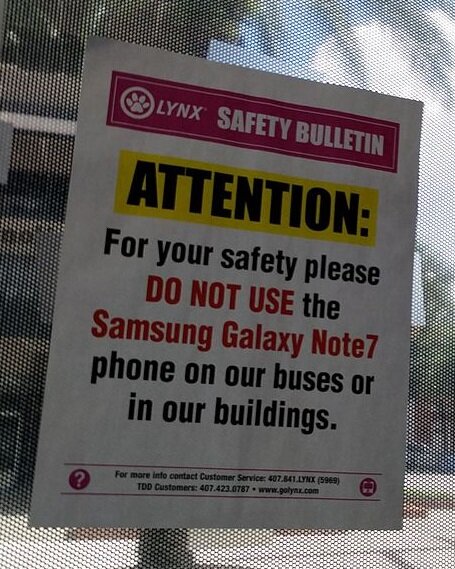Short-sighted thinking: The case of the “hot new smartphone”
Photo: "Samsung Galaxy Note 7 Bulletin" by elisfkc, licensed under the Creative Commons Attribution-Share Alike 2.0 Generic license
Here’s a story that shows what can happen when we don’t look beyond the expected and familiar, what relates to us, and what confirms our thoughts.
It’s a winner!
On August 2, 2016, Samsung debuted the Galaxy Note 7 to great fanfare in New York City. It was viewed as Samsung's challenger to the upcoming iPhone 7. Samsung's leaders believed that its new smartphone with a longer-life lithium-ion battery was a winner.
And customers appeared to think the phone was a winner, as well.
On August 19, sales started in markets including the United States. Over 200,000 pre-orders in Korea in two days caused shortages in supply and delays in release of the product in other markets.1
Exploding phones?
But, despite the phone’s popularity, all was not well. Within the first week of the launch, Samsung heard about the phone catching fire and the first report of a Note 7 "exploding" appeared in the news.2 Soon, more users posted pictures and videos of their phones overheating, exploding or catching fire. Time Magazine tallied “26 reports of burns and 55 reports of property damage.” It added, “A man in Florida says his vehicle caught fire when the Galaxy Note 7 smartphone charging inside his SUV burst into flames.”[3
A few weeks later, Samsung said the devices were burning up due to an “isolated battery cell issue.”4 Allegedly, a "problematic battery" had been installed in "less than 0.1 per cent of the entire volume sold," according to a Samsung official.”5
Here we see a glimmer of a mental trap affecting the situation. “Isolated” and “less than 0.1 per cent” were surely words meant to temper expectations outside of the company. “We have just a little problem, no worries.”
But the wording also suggested that Samsung leaders were engaging in selective perception. In this mental trap, we tend to "see things" based on our own frame of reference.6 It’s a bias in how we our brain processes information, in which the information tends to be selectively perceived in ways that align with our individual needs, goals, values, attitudes, and beliefs.7
Minimizing?
Could it be that Samsung’s decision makers, whose frame of reference was that of having previous successes with new smartphones and believing that the Note 7 would best the iPhone 7, were led to minimize any problem with the Note 7?
At that point, the U.S. Federal Aviation Administration and airlines worldwide told passengers not to turn on or charge the Note 7 while on a flight. Two weeks later, nearly 100 dangerous battery incidents had been reported in the U.S. The U.S. Consumer Product Safety Commission recall the phone.8
Samsung issued an initial recall of 2.5 million phones, including 1 million in the United States. The company had been using two different sources of batteries for the phone. It thought it had identified the cause of the problem as faulty batteries made by its own component division. Users were asked to trade in their new Note 7: Samsung would replace it with a new phone powered by the seemingly safer battery.
Influenced perceptions
At this point, we can consider the likelihood that Samsung’s leaders were entrapped by expectation bias. That’s the way in which we are prone to see what we expect to see, when our expectations influence our perceptions. Finding that one battery had a problem but that nothing seemed amiss with the other battery led to the expectation that the cause was found. This paved the way to the perception that the problem would be resolved by taking the faulty battery out of service. Only, that was not the case, as we shall see.
By early October, phone replacements were underway. But at the same time, reports emerged that Note 7s with the “safer” battery were catching fire.
At this point, things turned very bad for Samsung, culminating with the highly publicized evacuation of a Southwest Airlines flight when a Note 7 on board started smoking.9
Misdiagnosis
According to the Wall Street Journal, Samsung misdiagnosed the problem when it issued the first recall. Subsequent investigation showed that batteries from both sources were ill-sized and poorly manufactured.10
It is likely that Samsung’s engineers were misdirected by the Illusion of validity, which is when we “see” a pattern or a story in data that leads us to overestimate our ability to interpret the data and accurately predict outcomes as a result.11 By attributing the cause of the over-heating to the first battery, the engineers saw a clear story the required no more investigation.
‘We think alike’
Another mental trap that may have led Samsung to minimize the problem despite the evidence at hand is confirmation bias. Samsung was prone to pushing minimized explanations of the Note 7s problems because its leaders and engineers shared a common – positive - view of the company’s successes and technical abilities. This shared group thinking would tend to lead the leaders and engineers to subconsciously discount, dismiss, or ignore evidence that threatened what they saw as a very successful company with great technical prowess. When we think “my peers see it as I do,” that’s a clue that we are swayed by confirmation bias and a hint that we ought to do some independent thinking.
Also, the company was evidently hindered in it response to the Note 7’s problems by the very human flaw of Bayesian conservatism, which is our tendency to revise our beliefs insufficiently when presented with new evidence. In this case, Samsung’s initial thinking that it could repair or tweak the phone clearly did not capture the extent of the problem and as more evidence became available, its understanding of and response to the situation lagged, ultimately harming its reputation.
Having finally realized the magnitude of the problem with the Note 7, Samsung gave up. It stopped Note 7 production. It turned off users’ phones and encouraged customers to trade them for another Samsung option.12
To ultimately determine the cause of the phone’s intermittent overheating, Samsung built a test lab staffed with “700 researchers, 200,000 devices and 30,000 batteries in an attempt to replicate the cause of fires in the phones.”13
Premature launch?
While Samsung has been able to move on from the reputational and financial damage of the Note 7 failure, we should not leave this story without considering why Samsung took what turned out to be a flawed phone to market first place.
Observers surmise that Samsung rushed the product to market because of the impending Apple 7 launch, and this resulted in insufficient testing and quality assurance.14
A reason that Samsung may have been led to launch the product without more testing is that it had previously succeeded in packing more battery power in to its smartphones and this iteration of that process seemed like a continuation of a successful trend. Samsung likely felt that it was in familiar territory when it thinned down its new phone and battery. It was undercut by the familiarity heuristic, in which we tend to believe that our behavior is correct to the extent that we have done it before, that past actions are proof that current actions are appropriate. Samsung believed it knew what was needed to make its new state-of-the-art cellphone and battery - when it now looks like it did not know enough.
We tell ourselves stories
Samsung’s overconfidence was likely fed by the narrative fallacy, which arises from our vulnerability to overinterpretation and our preference for simple stories over raw facts. We think in terms of stories and relationships between facts – never mind whether the story is accurate and whether the facts are linked as the story suggests. Often the result is a distorted mental representation of the world; we think we understand when we don’t really understand.
Note: This is an elaboration of a previous post on Samsung’s Note 7 travails, Case 5: Getting burned by past successes.
Sources
1 https://medium.com/@dantealvaradoleon/product-launches-an-analysis-of-the-samsung-galaxy-note-7-an-explosive-launch-65adb459f2eb
2 http://time.com/4526350/samsung-galaxy-note-7-recall-problems-overheating-fire/
3 https://medium.com/@dantealvaradoleon/product-launches-an-analysis-of-the-samsung-galaxy-note-7-an-explosive-launch-65adb459f2eb
4 https://www.wired.co.uk/article/galaxy-note-7-issues-what-happened#
5 https://www.wired.co.uk/article/galaxy-note-7-issues-what-happened#
6 https://en.wikipedia.org/wiki/Selective_perception
7 https://onlinelibrary.wiley.com/doi/abs/10.1002/9781405186407.wbiecs025
8 https://www.wired.com/2017/01/why-the-samsung-galaxy-note-7-kept-exploding/
9 https://www.wired.co.uk/article/galaxy-note-7-issues-what-happened
10 https://www.wsj.com/articles/samsung-investigation-blames-battery-size-for-galaxy-note-7-fires-1484906193
11 https://en.wikipedia.org/wiki/Illusion_of_validity
12 https://www.washingtonpost.com/business/how-samsung-moved-beyond-its-exploding-phones/2018/02/23/5675632c-182f-11e8-b681-2d4d462a1921_story.html
13 https://www.forbes.com/sites/maribellopez/2017/01/22/samsung-reveals-cause-of-note-7-issue-turns-crisis-into-opportunity/#5282043c24f1
14 https://medium.com/@dantealvaradoleon/product-launches-an-analysis-of-the-samsung-galaxy-note-7-an-explosive-launch-65adb459f2eb

